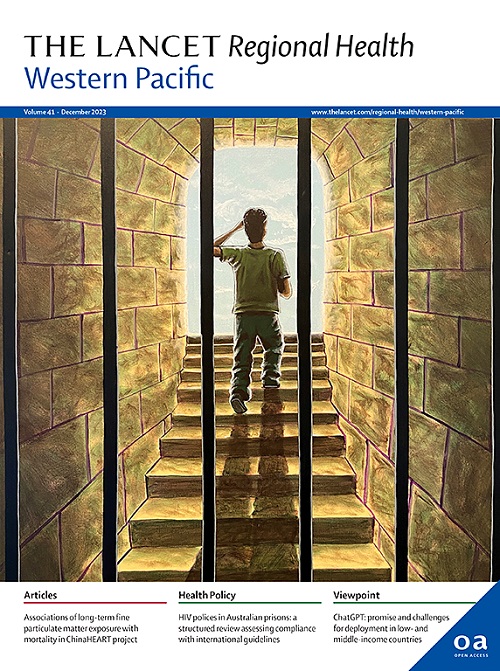Birth cohort-specific smoking patterns in Japan (1906–2004): a population-based study from the NC-CCAPH consortium
IF 7.6
1区 医学
Q1 HEALTH CARE SCIENCES & SERVICES
引用次数: 0
Abstract
Background
This study aimed to estimate Japan’s age-specific history of smoking prevalence, initiation, cessation, and intensity by birth cohort, using data from multiple cohort studies.
Methods
We pooled data from eight eligible cohorts surveyed between 1989 and 2020 as part of the National Center Cohort Collaborative for Advancing Population Health (NC-CCAPH). An Age-Period-Cohort model was employed to estimate birth cohort- and sex-specific smoking patterns for individuals born between 1920 and 1999.
Findings
Among 393,023 participants (40.9% female, mean age 51.8 years), smoking prevalence peaked in early adulthood (20s–30s) and declined with increasing age. Recent birth cohorts showed lower prevalence and smoking initiation in both sexes, albeit with increases in mid-female cohorts (1960s–1980s). Smoking cessation surged in the late 1990s and peaked around 2010, coinciding with tax-driven cigarette price hikes. Peak cigarette consumption occurred in 1990, followed by a steady decline. However, all birth cohorts maintained a mean consumption above 10 cigarettes smoked per day for both sexes.
Interpretation
This study highlights a generational shift in smoking behavior, in which younger birth cohorts smoked less and quit earlier than older birth cohorts. The study also reveals that smoking behaviors in males were strongly influenced by cigarette accessibility, such as price increases, while smoking initiation in females was more likely affected by societal changes, especially in the evolving roles of women. Smoking intensity remained stable across cohorts and sexes, emphasizing the need for stronger health policies, including higher tobacco taxes, to further reduce smoking and its health impact.
Funding
This study was conducted within the National Center Cohort Collaborative for Advancing Population Health (NC-CCAPH) and supported by grants from the Japan Health Research Promotion Bureau (JH) (2019-(1)-1, 2024-B-05).
日本出生队列特定吸烟模式(1906-2004):一项来自NC-CCAPH联盟的基于人群的研究
本研究旨在利用来自多队列研究的数据,通过出生队列估计日本特定年龄的吸烟率、开始吸烟、戒烟和吸烟强度的历史。方法:我们汇集了1989年至2020年期间8个符合条件的队列的数据,这些数据是国家促进人口健康中心队列协作(NC-CCAPH)的一部分。采用年龄-时期-队列模型来估计1920年至1999年间出生的个体的出生队列和性别特定的吸烟模式。在393,023名参与者中(40.9%为女性,平均年龄51.8岁),吸烟率在成年早期(20 - 30岁)达到顶峰,并随着年龄的增长而下降。最近的出生队列显示,尽管中期女性队列(20世纪60年代至80年代)吸烟率和开始吸烟的人数有所增加,但男女的吸烟率和开始吸烟的人数都较低。上世纪90年代末,戒烟人数激增,并在2010年左右达到顶峰,与税收驱动的卷烟价格上涨相吻合。香烟消费在1990年达到顶峰,随后稳步下降。然而,所有出生队列的男性和女性每天的平均吸烟量都在10支以上。这项研究强调了吸烟行为的代际变化,年轻出生的人群比年长出生的人群吸烟更少,戒烟更早。研究还表明,男性的吸烟行为受到香烟可及性的强烈影响,如价格上涨,而女性的吸烟行为更有可能受到社会变化的影响,尤其是女性角色的演变。吸烟强度在各群体和性别之间保持稳定,强调需要更强有力的卫生政策,包括提高烟草税,以进一步减少吸烟及其对健康的影响。本研究由国家人口健康促进中心队列协作(NC-CCAPH)进行,由日本健康研究促进局(JH)资助(2019-(1)- 1,2024 - b -05)。
本文章由计算机程序翻译,如有差异,请以英文原文为准。
求助全文
约1分钟内获得全文
求助全文
来源期刊

The Lancet Regional Health: Western Pacific
Medicine-Pediatrics, Perinatology and Child Health
CiteScore
8.80
自引率
2.80%
发文量
305
审稿时长
11 weeks
期刊介绍:
The Lancet Regional Health – Western Pacific, a gold open access journal, is an integral part of The Lancet's global initiative advocating for healthcare quality and access worldwide. It aims to advance clinical practice and health policy in the Western Pacific region, contributing to enhanced health outcomes. The journal publishes high-quality original research shedding light on clinical practice and health policy in the region. It also includes reviews, commentaries, and opinion pieces covering diverse regional health topics, such as infectious diseases, non-communicable diseases, child and adolescent health, maternal and reproductive health, aging health, mental health, the health workforce and systems, and health policy.
 求助内容:
求助内容: 应助结果提醒方式:
应助结果提醒方式:


